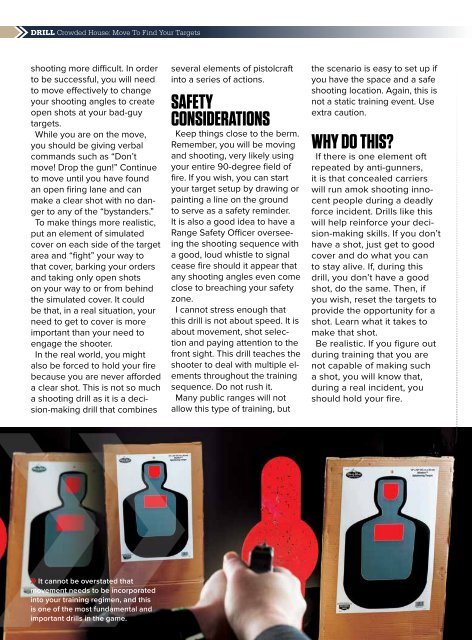You also want an ePaper? Increase the reach of your titles
YUMPU automatically turns print PDFs into web optimized ePapers that Google loves.
DRILL Crowded House: Move To Find Your Targets<br />
shooting more difficult. In order<br />
to be successful, you will need<br />
to move effectively to change<br />
your shooting angles to create<br />
open shots at your bad-guy<br />
targets.<br />
While you are on the move,<br />
you should be giving verbal<br />
commands such as “Don’t<br />
move! Drop the gun!” Continue<br />
to move until you have found<br />
an open firing lane and can<br />
make a clear shot with no danger<br />
to any of the “bystanders.”<br />
To make things more realistic,<br />
put an element of simulated<br />
cover on each side of the target<br />
area and “fight” your way to<br />
that cover, barking your orders<br />
and taking only open shots<br />
on your way to or from behind<br />
the simulated cover. It could<br />
be that, in a real situation, your<br />
need to get to cover is more<br />
important than your need to<br />
engage the shooter.<br />
In the real world, you might<br />
also be forced to hold your fire<br />
because you are never afforded<br />
a clear shot. This is not so much<br />
a shooting drill as it is a decision-making<br />
drill that combines<br />
several elements of pistolcraft<br />
into a series of actions.<br />
SAFETY<br />
CONSIDERATIONS<br />
Keep things close to the berm.<br />
Remember, you will be moving<br />
and shooting, very likely using<br />
your entire 90-degree field of<br />
fire. If you wish, you can start<br />
your target setup by drawing or<br />
painting a line on the ground<br />
to serve as a safety reminder.<br />
It is also a good idea to have a<br />
Range Safety Officer overseeing<br />
the shooting sequence with<br />
a good, loud whistle to signal<br />
cease fire should it appear that<br />
any shooting angles even come<br />
close to breaching your safety<br />
zone.<br />
I cannot stress enough that<br />
this drill is not about speed. It is<br />
about movement, shot selection<br />
and paying attention to the<br />
front sight. This drill teaches the<br />
shooter to deal with multiple elements<br />
throughout the training<br />
sequence. Do not rush it.<br />
Many public ranges will not<br />
allow this type of training, but<br />
the scenario is easy to set up if<br />
you have the space and a safe<br />
shooting location. Again, this is<br />
not a static training event. Use<br />
extra caution.<br />
WHY DO THIS?<br />
If there is one element oft<br />
repeated by anti-gunners,<br />
it is that concealed carriers<br />
will run amok shooting innocent<br />
people during a deadly<br />
force incident. Drills like this<br />
will help reinforce your decision-making<br />
skills. If you don’t<br />
have a shot, just get to good<br />
cover and do what you can<br />
to stay alive. If, during this<br />
drill, you don’t have a good<br />
shot, do the same. Then, if<br />
you wish, reset the targets to<br />
provide the opportunity for a<br />
shot. Learn what it takes to<br />
make that shot.<br />
Be realistic. If you figure out<br />
during training that you are<br />
not capable of making such<br />
a shot, you will know that,<br />
during a real incident, you<br />
should hold your fire.<br />
12<br />
›› It cannot be overstated that<br />
movement needs to be incorporated<br />
into your training regimen, and this<br />
is one of the most fundamental and<br />
important drills in the game.<br />
WWW.USCCA.COM


